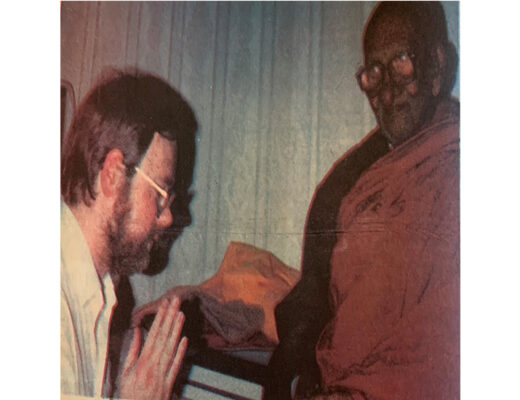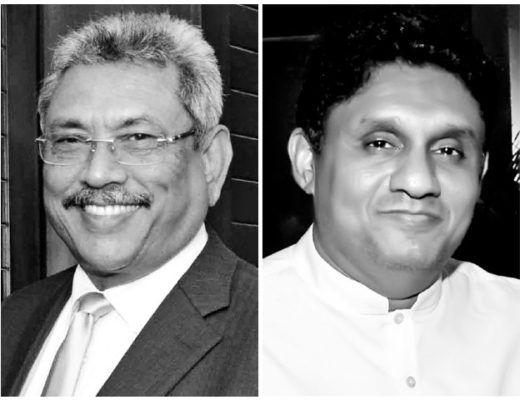A new book titled, “ Tamil Tigers Debit to America” has been authored by Daya Gamage and published by the Library of Congress (under control No. 2016913508) ; ISBN:1537053485 & 13:9781537053486 respectively. The author is a Sri Lankan who was an old Trinitian , who read Economics and European Political history at Peradeniya; subsequently become an academic in a United States University, prior to joining the US Federal Service.
Daya Gamage had worked with the third and the most Senior Political American Councillor, Dr. Robert K. Bloggs, attached to the US Embassy in Colombo from 1989 to 1993. Subsequently he read Law at the University of Colombo thus making him an increasingly authoritative source of legal analysis, attached to the US Embassy in Colombo.
During his attachment with the US Embassy in Colombo with Dr. Bloggs, they experienced the JVP insurrection in the South as well as the Tamil struggle in the North that formed into a militant rebel movement named the LTTE known as Tamil Tigers, and became the most ruthless terrorist group in the world. In Sri Lanka they carried out a destruction policy by killing and maiming thousands of innocent people, including the Buddhist Clergy, Senior Politicians ( both Sinhala and Tamil), detonating bombs indiscriminately and even mercilessly slaughtering infants and young children. On 16 May 2009, Sri Lankan Government Forces decimated the entire LTTE organisation into smithereens.
During this calamitic period Daya Gamage undertook field tours outside Colombo with senior officers of the Embassy and Foreign Service officials assigned to Colombo from Washington and Congressional Delegations. His subsequent solo, well-planned, tours in remote areas in the country to assemble ‘far-reaching socioeconomic-political data, for investigative-analytical reports made him recognised in 1988 by the US Department as the Sri Lanka’s diplomatic mission’s ‘ political specialist’. Consequently,he received a coveted ‘Meritorious Honour Award for Superior Performance’.
The American Ambassador at the time commended on Daya Gamage in her assessment as follows:
“ The U.S. Mission has benefitted in many other ways from Mr. Gamage’s unusual initiative and resourcefulness. Information on political attitude probably would not have been forthcoming if he were travelling with an American Officer.”

During the terrorist war period, the influential political-diplomatic arm of the LTTE in the US, Ilankai Tamil Sangam carried an analysis in their website:
http://www.sangam.org/2008/08/Stalingrad.php?uid=3046, defending the LTTE’s military struggle of the Tamil Tigers, and identifying Gamage and his online daily newspaper Asian Tribune with four others, as obstacles to the Tamil Struggle in Sri Lanka.
Upon Retirement
Once Daya Gamage relinquished his duties at the US Diplomatic Mission in Colombo, he managed to formulate his knowledge and experience about the US strategy and the LTTE’s contribution to Americansin a concise and unbiased form, by writing a book containing 577 pages (under copyright ©2016 Daya Gamage); ISBN: 1537053485 & ISBN 13:9781537053486 ,which can be ordered through Amazon Books ‘on line’.
Overview
In the introduction of his book, Gamage asserts to what extent the ‘Foreign policy strategies of the U.S’ had been multifarious and t’he US Agency for International Development (US AID) had become an effective Foreign Policy Instrument of the State Department, Congress, and the White House. ‘In 2004, under George Bush Administration the Millennium Challenge Grantfor the Third World nations was ‘selected’. “Occasionally, the U.S seems to exercise its military supremacy to impose its Brand Rule of Law and Governance”.
Gamage discusses in his book how the “ US officials and bureaucrats in the Department of Political Affairs collaborated to influence Sri Lanka in its governing structure”. The Sri Lankan Tamil Diaspora, he states, was impressively influential in building American perspective toward Sri Lanka during their struggle.
‘Tamil Tigers Debt to America’ examines the Sri Lankan National issues that go beyond ethnicity, and records how Tamil nationalism emerged since Ceylon gained Independence in 1948; and highlights the alarming danger signals from both Tamil and Sinhala nationalism.
Towards the end of 1970, the LTTE was able to charm the West , particularly the US Department of State. The book contains impressive and graphical accounts of the “ U.S. Foreign-Policy Adventurism and Sri Lanka’s Dilemma” that run into detailed pages and setting out American Agenda from 1980 to 2016. This comprehensive ‘insider account’is dealt with by the author, who once worked in tandem with the American Dr. Robert K. Boggs of the US Department of State and Tilak Samaranayake, who formerly worked for the US Agency for International Development.
Illustrative Output
In a graphical account Daya Gamage highlights some significant photographs covering the following: The ‘UN Correspondent for the Nation at the time Barbara Crossette, who occasionally received ‘strange requests’ from either editors in the “New York Times,’ and US pro-LTTE sympathisers to reflect on a farcical account about how the Sri Lankan Intelligence Service operated a torture centre on the 4thfloor of the airport, which anyone who has visited the Airport knows to what extent this appears to be fabricated; there is no fourth floor at the Katunayake Bandaranaike Airport!

Amongst the graphical news with pictorial content, the Author can be seen speaking to the top brass of the USA hierarchy, Sri Lankan Government top officials and with the leaders of LTTE including the Sri Lankan President at the time, Mahinda Rajapaksa in August 2007; Prime Minister Ranil Wickremesinghe with the US Deputy Secretary of State, Richard Armitage, in Colombo in 2002; US Congressman Danny Davis being greeted by the LTTE Police Chief Nadasan in Kilinochchi in 2005; US Assistant Secretary Robert Blake in 2010, with a delegation led by Rev.Fr. S. J. Emmanuel (Germany); Dr. Elias Jeyararajah, Mrs. Grace Williams (US) and Suren Surendiran (UK); Also photograph of the LTTE Leader Prabhakaran with Dr. Anton Balasingham, Visuanathan Rudarakumaran in 2007; a picture of Rajiv Gandhi with Prabhakaran and Anton Balasingham in1987; Norwegian peace negotiator Eric Solheim conferring with P. Tamilselvan in Kilinochchi; President Bush and Ranil Wickremesinghe in the White House on 5 November 2003 etc.

WikiLeaks Cables.
The book covers also a segment of the US Embassy in Sri Lanka’s classified cables to Washington sent by Robert Blake (Ambassador at the time), which was disclosed by WikiLeaks giving a glimpse of the endeavour by the US to arrange a surrender of the LTTE cadre. The cable is highlighted in the book as follows:

“Ambassador contacted senior GSL officials throughout the day, including Secretary of Defence Gotabaya Rajapaksa and Foreign Minister Bogollagamato urge acceptance of a mediated surrender of the remaining Tigers and maximum restraint on the part of the military to avoid further civilian casualties, particularly after the reports from the Bishop of Mannar of continued high number of civilians in the safe zone”. However, the author reveals how President Rajapaksa refused to accept mediated surrender on the grounds that the fighting was all but over, and troops had been instructed to accept anyone who wished to surrender.
In a separate chapter the author describes ‘ the American Agenda through FSO Eyes,’ where it mentions
about a Group of FSC having a meeting at the US Embassy Office in Colombo in 1990 to exchange notes of significant developments in Sri Lanka’s political scenario.
The book contains the author’s personal discussions with Schaffer about the American Agenda between 1980- 2016, and also an interesting interview with Ambassador Teresita. It further discusses the “ deep rooted US belief and the war with the Tamils, during Secretary of State John Kerry’s period and about the US Policy Guide and how “Sri Lanka engrossed in Ethnic warfare particularly about the self-rule Federal structure in the North and East”.
The book deals with areas on Sri Lanka’s diplomatic strategy and ambiguous US reports: ‘How the Tamil diaspora filled the void; strategic communication and argues for the case for a new vision at the US Embassy in Sri Lanka. It also deals with how US & Third World trust deficit; about the Sri Lankan Diplomats in the United States in Deep Slumber and its Consequences; LTTE Influence in the International Community; How the Sri Lanka Mission slept on House Resolution for eighteen months;
‘A Professional Strategy to Delegitimise Sri Lankan State; Barbara Crossette’s Prophecy; Historic Evolution of the Homeland Concept and an Independent Tamil State; how the United States leans on Tamil Homeland; their secessionist demand for Tamil Homeland with a question Why ?; The Birth of the Secessionist concept; The US Trajectory toward a war-crime allegation; The US war reports on Sri Lanka; Ambiguous information; US Department of Defence: The use of Human shield; US ‘Policy Design’ for Sri Lanka: How the US imposed the ‘ Carrot and Stick Policy on Sri Lanka in 2002 and 2015 including global experts’ scrutiny of war-crimes allegation and the final chapter discusses the International Humanitarian law and it’s applicability to the LTTE’.
The book also exposes either ignored or unknown gradations of the post 2009 developments in which Washington and the Tamil diaspora played, and even currently playing at present, that have threatened Sri Lanka as a nation, her sovereignty and territorial integrity.

The entire argument of the author of the Book on “Tamil Tigers’ debt to America” is about an unbiased projection as to how Washington took a softer attitude towards the LTTE . It concludes stating, how during the final 3-4 weeks of the war when Washington saw the imminent defeat of the Tamil Tigers they were contemplating to remove the hierarchy of the ‘ Tiger Leadership’ from the battle zone with the intention of using the secessionist movement in a different from as a pressure group to effect changes in Sri Lanka.
One needs to read the entire book to get an idea of the US strategy on Sri Lanka, which seems to prove about some of the utterings of Sri Lankan Parliamentarians today. It would have been a jolly good reproduction of various sections of the book, as well as interesting reading, if only the writer was able to obtain Daya Gamage’s authority to do justice to his book through columns of ‘Ceylon Today’ newspaper, but all his efforts to reach Daya Gamage has been fruitless even after making written requests to the Library of Congress ( where the book has been published under their control number : 2016913508) and also the writer having written to the CreateSpace Independent Publishing Platform, North Charleston, South Carolina.

The writer will appreciate, in the circumstances, if anyone who knows about Daya Gamage’s contact details contacting the writer by email as below, as it is a book that must be read by every Sri Lankan.
Picture credit: Daya Gamage ( extracted from his book on Tamil Tigers Debt to America and google pics






